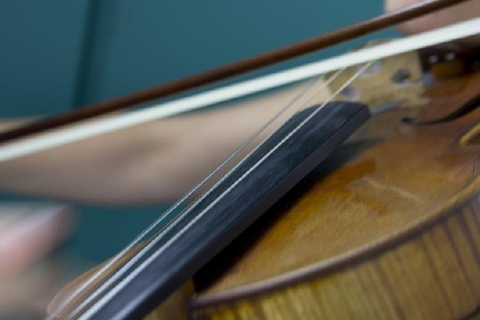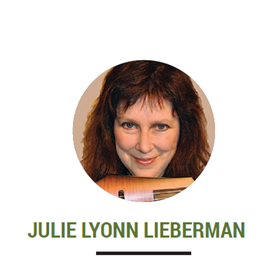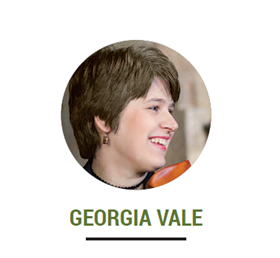Three teachers give their thoughts on eliminating right hand, arm and shoulder tension in a young student

The dilemma
I began teaching a six-year-old violin student around eight months ago. She is highly musical with a supportive mother, so is progressing fast in terms of note and rhythm learning. She also plays remarkably well in tune.
However, she plays with an unusual amount of tension in bothher right shoulder and right hand. She clutches the bow with a fist and plays with a raisedshoulder. I am constantly asking her to relax her bow hold, which she can do perfectly untilshe begins to play. I am also trying to get across the concept of a relaxed bowing arm: raising the upper arm without raising the shoulder and using a whole, straight bow by extending herlower arm from the elbow.
I have demonstrated these ideas to her on her own instrumentby guiding her bow, but without lasting effect. Am I expecting too much from a six-year-old?

Your student is fortunate to have such an alert teacher. Look at the instrument’s position first. If the violin is too far out in front, it can drive the position of the arm too far back along the right side. This causes the shoulder to lift, owing to the structural limitations of the rotator cuff, which achieves its greatest mobility when the right elbow is positioned over the right of the hip bone.
Secondly, if the face of the instrument is too flat (parallel to the floor) rather than tilted to meet the bow hand, the student might need to lift too high to reach the lower strings. This can also cause a chronically lifted right shoulder. Once the instrument is placed to invite a relaxed right shoulder, stand behind the student, ask her to put her arms by her sides (with the instrument still in its case) and lightly press downwards with your palm on top of her right shoulder. Ask her to push up against your hand for a few seconds, relax, and then repeat. This is an isometric exercise that induces deeper muscular relaxation, and helps to re-educate her as to the correct shoulder position.
Additionally, try handing her a pencil and ask her to draw a picture or write her name to see if the tension is a habit associated with other activities. Then invite her to draw in the air, holding the pencil like a bow, to help build new habits for the hand. These isolation exercises are important because a child this age would have enormous difficulty focusing in such a manner while playing the violin simultaneously.
Then avoid long bows until she can establish down-bow and up-bow patterns using a few inches in the middle of the bow, with a relaxed hand and shoulder, before adding any bow length. This will also help you to determine whether there is one area of the bow that particularly contributes to these problems.
Julie Lyonn Lieberman is the author of seven books and the artistic director for the US-based Strings Without Boundaries summer programme: julielyonn.com

Children as young as six are capable of a great deal, so don’t lower your expectations. The way that six-year-olds tend to work is very different from that of children over the age of eight, where language seems to be more important. It is important that the pupil shouldn’t really know that there is an issue, especially as she can’t correct it for herself.
Aim for small improvements and don’t try to sort it all out at once. Tension comes from within; the desire to ‘get it right’ and to play the music as she hears it in her head can both be big contributors, so making it less important to ‘get it right’ is essential.
Try singing at the same time as playing, so that the pupil is focusing more on the music and less on the physical actions. This will help make her body more relaxed. It may be useful to buy a small soft toy and put it in the bowing hand, telling her not to crush the toy as she plays. The advantage with this is that she can take the toy home and replicate the feeling.
Young people are fantastic mimics and visual learners. They also work best when games are involved. You could start each lesson with a series of copy games, starting with the most simple and gradually extending the range of bowing challenges. I would also build games into the music so that there are times when she has to use the bow differently, pluck or just sing a passage, to give variety to the arm movements. Exaggeration will help to show and feel when there is tension. Exaggerated movements can also show how the arm needs to work – you can then refine the movements.
Jane Cutler is a cellist and the principal and musical founder of the DaCapo Music Foundation, UK: www.dacapo.co.uk

Eliminating tension can be a very tricky issue in violin playing. All credit to you for trying to deal with this problem right from the start – and I certainly don’t think you are expecting too much. I think you can ask a great deal of young children, so long as you couch it in the right terms.
Often, it can be useful to deal with the bigger ‘engine’ (the arm as a whole) before the smaller one (the hand or fingers). You could support the student’s elbow and wrist while her bow is on the string – her whole arm can then be relaxed. If you then take away your hands, you can test this – her arm will drop like a stone (but catch it!). She can then learn to ‘catch’ her own arm, and in this way she will feel how little effort is needed to hold the arm weight.
Placing the bow on the string at the heel enables the child to release her grip on the bow. She can take off individual fingers, even resting the length of her thumb on the violin, so she can feel how the strings will support the bow weight.
Also, have you heard of Bow Hold Buddies? These are clever little devices that sit on the bow and encourage a good bow-hold – fun, too! The front ‘frog’ part may be too big for your student but the ‘fish’ part is very helpful for the little finger. Something to consider, perhaps.
Finally, there is the issue of motivation. Sometimes technique requires the repetition of remedial exercises, which requires a certain amount of discipline. Rewards work well: perhaps offer her a sticker if she can manage to play, for example, ten bows on any string with a soft hand and an ‘empty’ elbow and shoulder.
UK pedagogue Georgia Vale teaches violin, viola and piano privately, and is the author of the Hey Presto! violin series: www.heyprestostrings.com
This article was originally published in the January 2015 issue of The Strad



































No comments yet